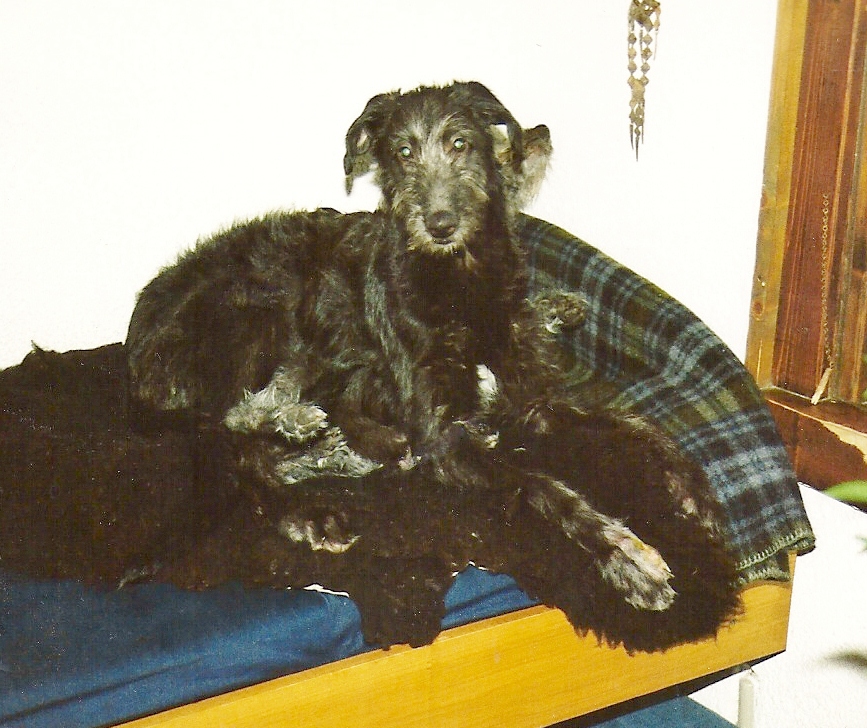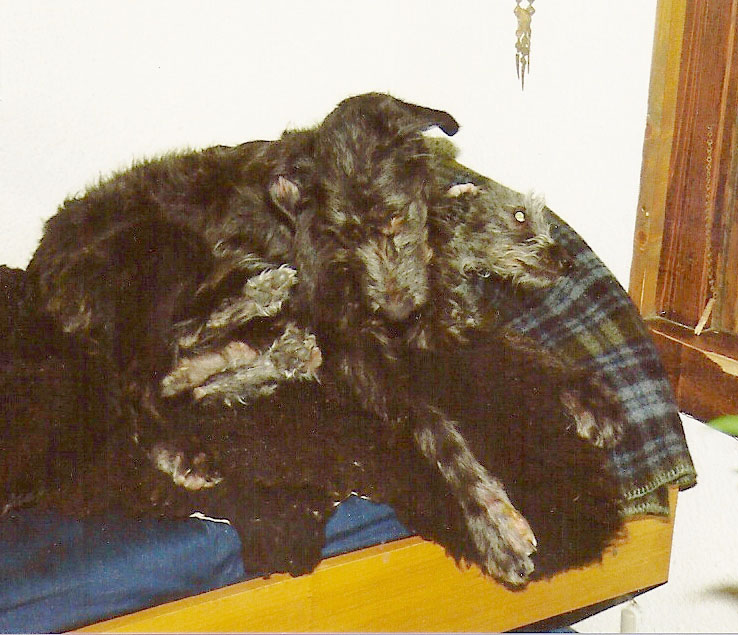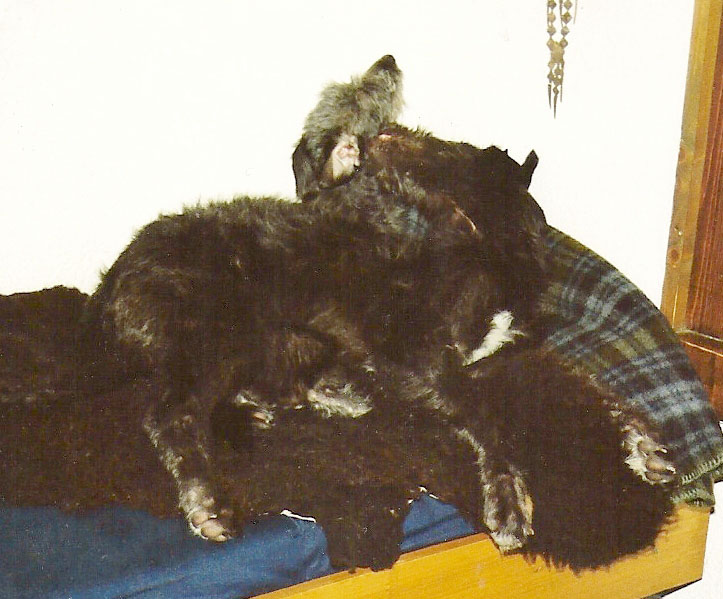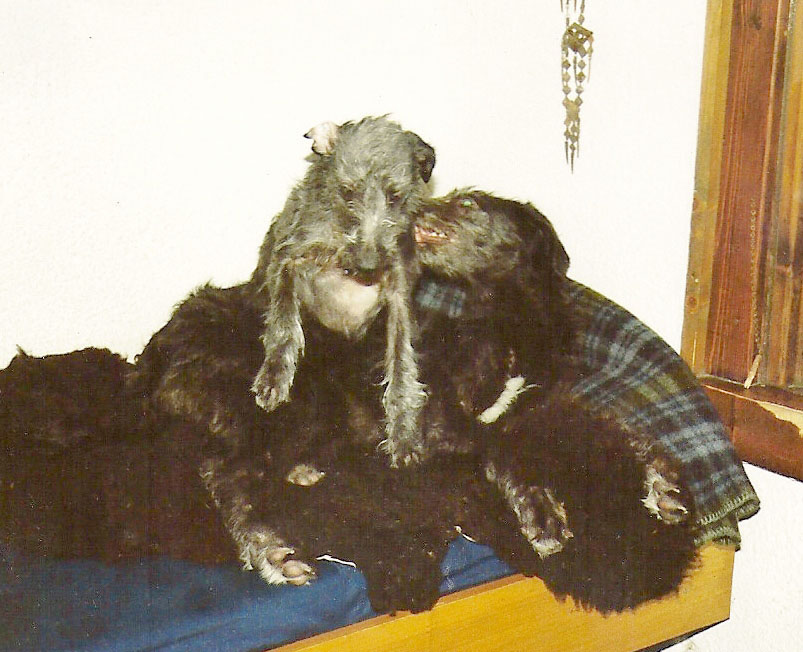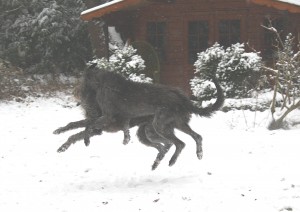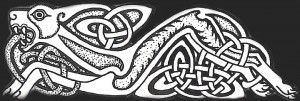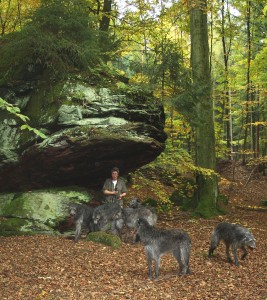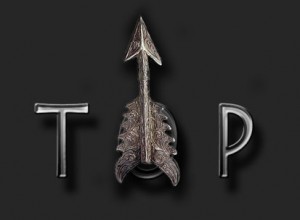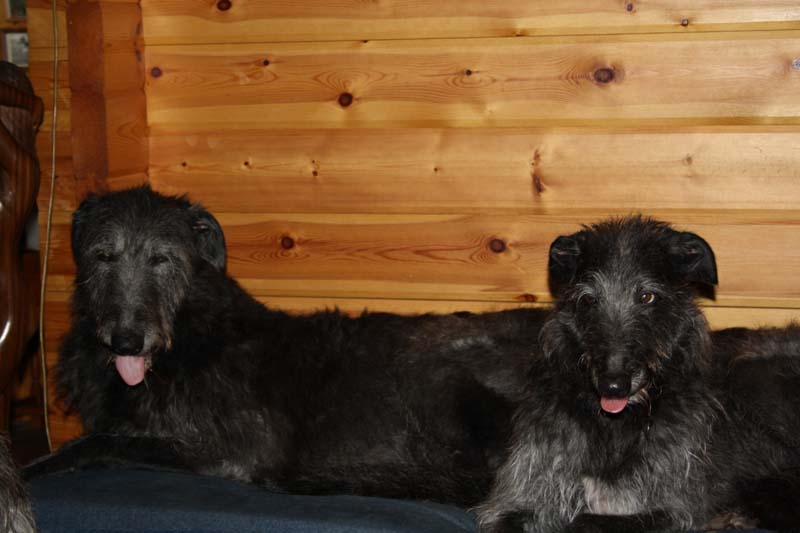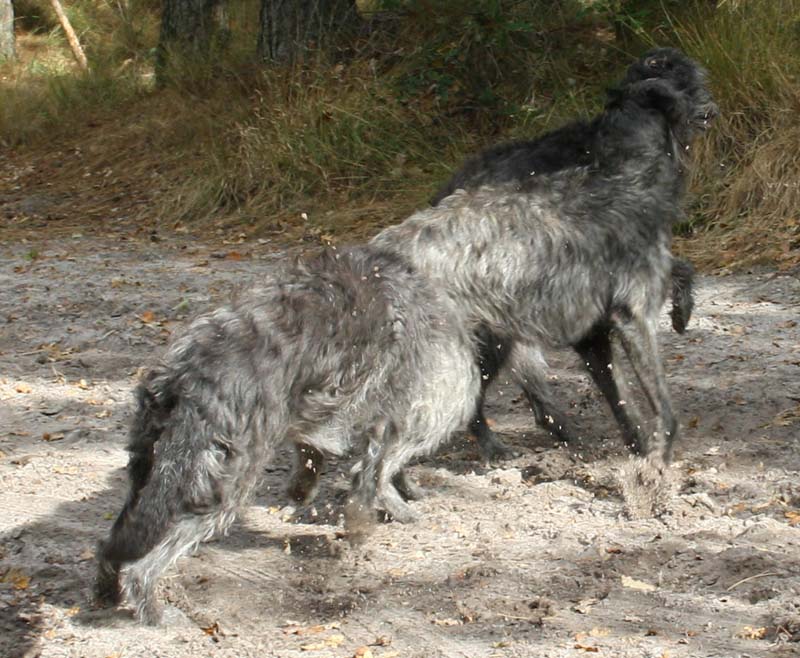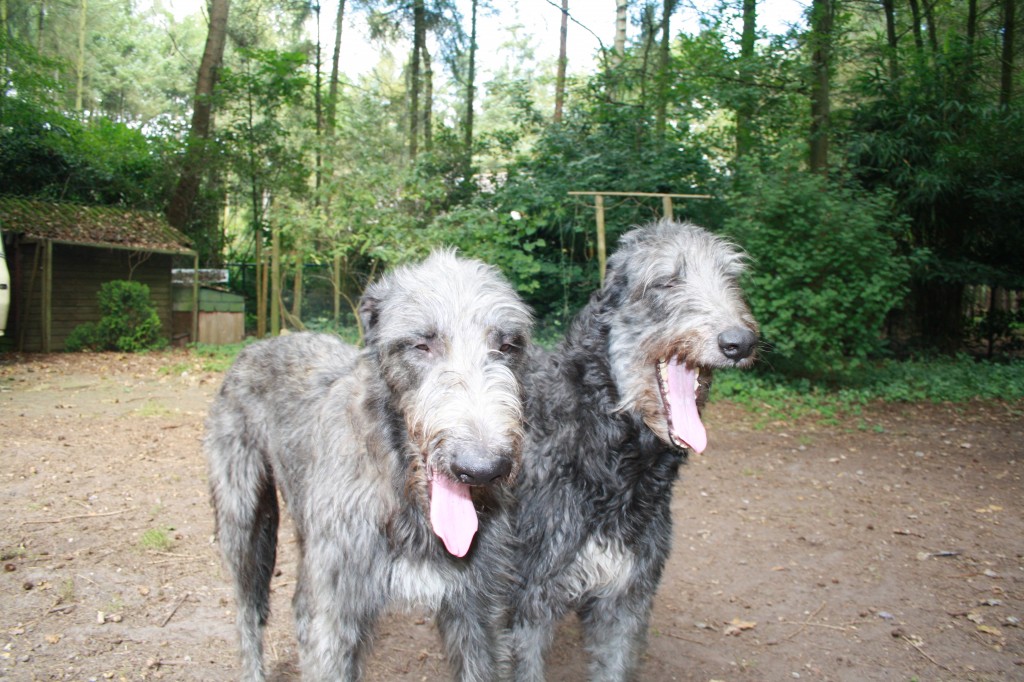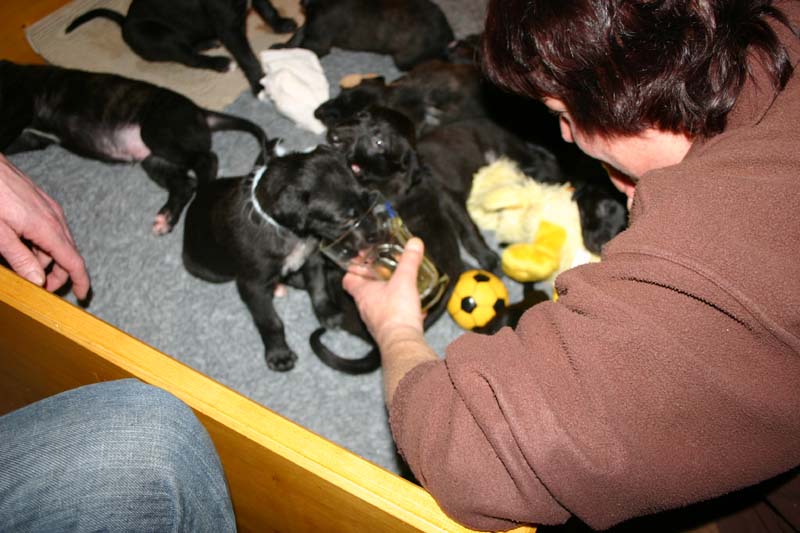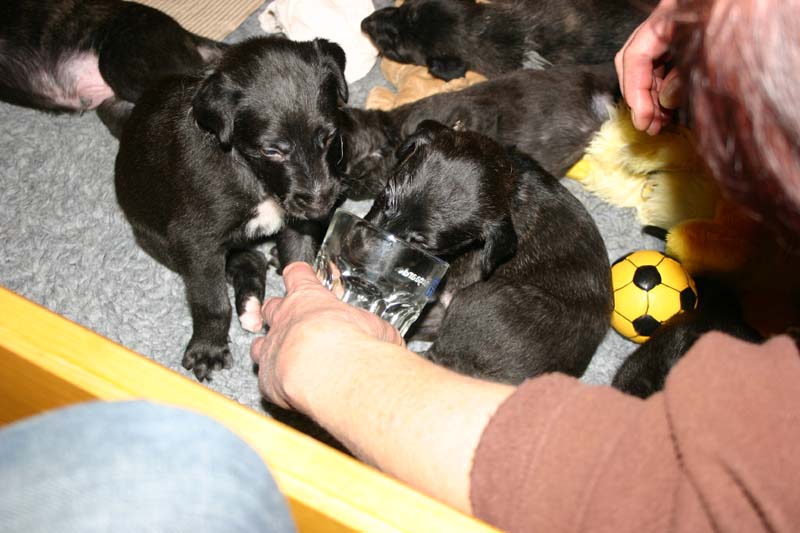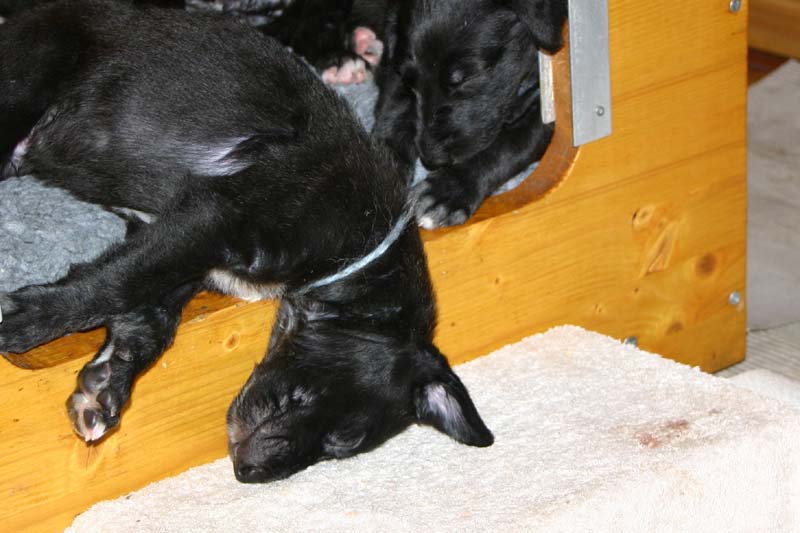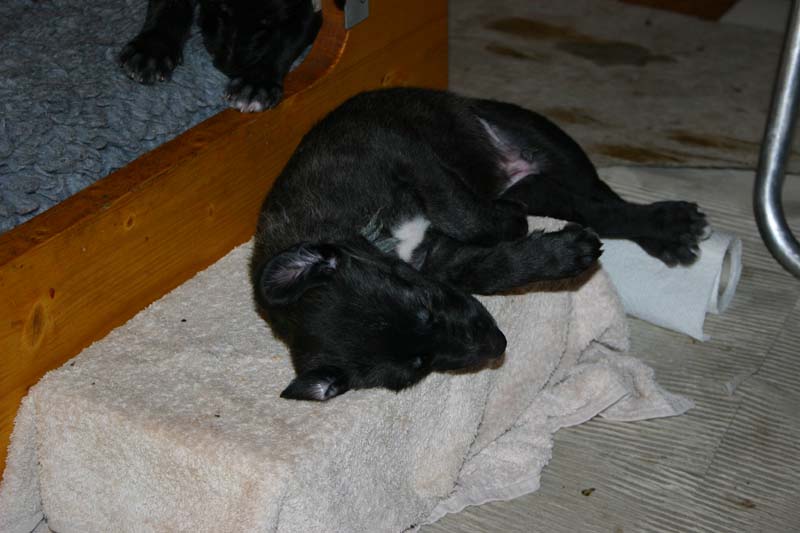Laughing with and because of Deerhounds
 Flamingo Calhoun
Flamingo Calhoun
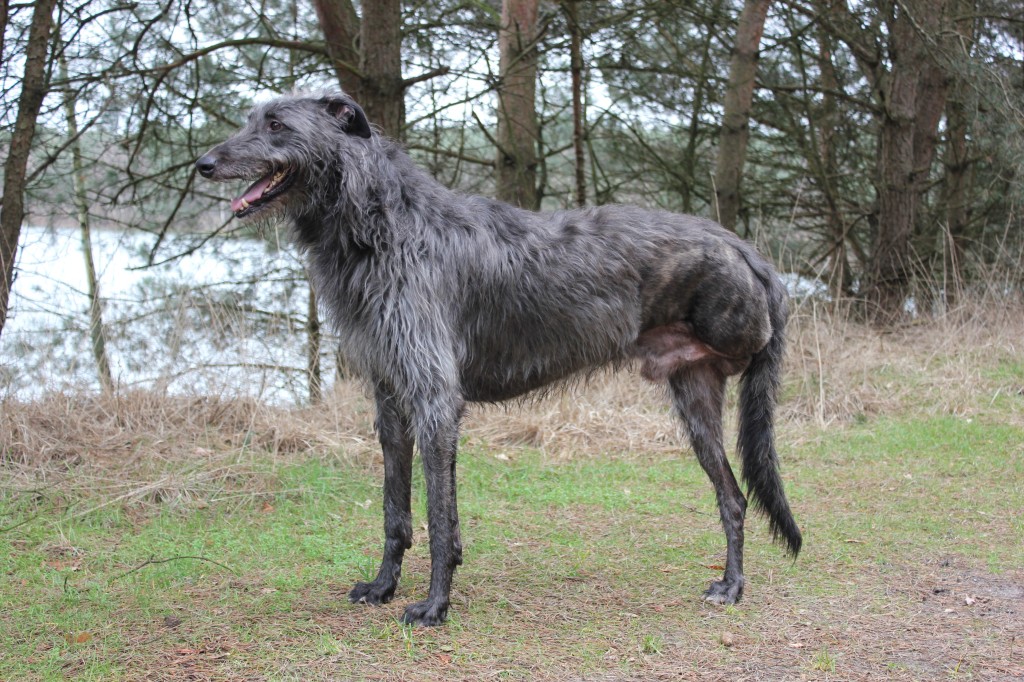 The Thursday before the Jahresausstellung of 2013 in Germany, we were at Sonja in Hermannsburg. The two young neighbour girls of Sonja were fascinated by so many of those big Gray hounds together and came to take a look.
The Thursday before the Jahresausstellung of 2013 in Germany, we were at Sonja in Hermannsburg. The two young neighbour girls of Sonja were fascinated by so many of those big Gray hounds together and came to take a look.
When the youngest saw Calhoun she said to her sister; “Look, he can retract his paw very high!”
 Brandir still fits on lap.
Brandir still fits on lap.
Brandir is n ow seven and a half months young and is always amazed that everything is so shrinking. First he could walk under the table now he puts his head on the table. He clearly enjoys that he can observe everything better and I wait for the moment he picks things from the table or the countertop. Until now he is very obedient, only picks up old newspapers from the bucket for makin
ow seven and a half months young and is always amazed that everything is so shrinking. First he could walk under the table now he puts his head on the table. He clearly enjoys that he can observe everything better and I wait for the moment he picks things from the table or the countertop. Until now he is very obedient, only picks up old newspapers from the bucket for makin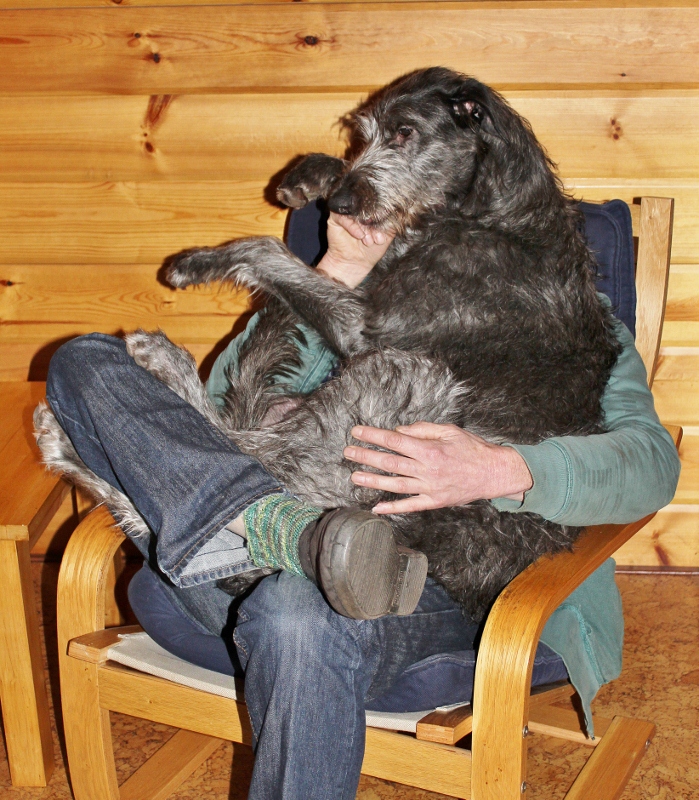 g fire and has only demolished his or Calhoun’s toys. He is good at rip out eyelets and destroying beeps.
g fire and has only demolished his or Calhoun’s toys. He is good at rip out eyelets and destroying beeps.
At Sonja Bernice has discovered the wooden furniture and this is a bit at work. Hopefully Brandir will not do this. What Brandir still likes to do is lie on the lap. A few months ago this was for a long time, which was getting shorter and now it’s happy for Simon just a few minutes because Brandir now weighs 33 pounds! But it still needs to be here every night. It is hoped for Simon that Brandir will at some point see that he is too big for it!
 Excercise
Excercise
You know of course that the Deerhound is a sighthound. That means it is’ a dog built for fast sprinting, and it’s very important for this breed’s mental and physical condition for it to be able to regularly enjoy itself by going wild either with a playmate or squeaky toys. Dogs are social animals and Deerhounds are difficult to raise successfully as single dogs. It’s good to have two dogs of the same age or two pups from the same litter or a high energy playmate from another tough, tolerant breed that recalls well. You will really enjoy having two pups playing together!
As a human you can never be the ultimate playmate for your dog. Their rhythm of life, their strength, their language, all are mentally and physically just too different from your own. Concerning their rhythm of life, pups have a habit of often for short periods playing intensely and in between taking short deep naps. As they age both these periods become longer. You can’t keep up with that, it’s exhausting just to watch it!
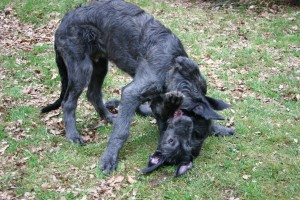 Concerning their strength… during their play sessions they learn how to use their body, they develop their musculature and skeleton, they measure their strength and learn how to manage and control it.
Concerning their strength… during their play sessions they learn how to use their body, they develop their musculature and skeleton, they measure their strength and learn how to manage and control it.
They let each other know that if they bite too hard retaliation will happen and that’s how they learn just how far they can go. As a human you will tend to be either too soft with them so the puppy will think it can bite even harder, or you will be too hard a disciplinarian and the pup could become hand-shy.
Concerning language… we can teach a dog a great deal by our tone of voice and our body language – but do you always understand your dog? There are lots of owners that have had a dog (or more) for a long time and yet fail to see that it’s frightened or going to attack. You can often see that a dog is trying to make something clear to its owner who doesn’t understand or gets the wrong idea. In both cases the dog becomes the victim.
Two puppies can at least communicate with each other and always understand each other! It often happens that a puppy that grows up alone becomes a lethargic dog that trundles along behind its owner. Often the owner’s walking speed is too slow so that the dog is not induced to activity, and nine times out of ten there isn’t a dog to be found that can really play with a Deerhound. If there is one then it is usually only for a very short time of the day. However, having said all this, the unshared one-on-one relationship just between you and your puppy is an incredible experience .
The advantages of two pups from the same litter:
In the most critical growth period (until about 7 months) it’s sufficient to leave them out in the nearest fenced/secure area (a garden of about 5000 square feet would be fine), to let them play, sniff around, and do their business. If they tire then they will go straight back to their beds. They have these wild play times of course numerous times (about 5 or 6) a day. A single pup wandering about by itself will not get sufficient exercise (which stimulates the appetite) to eat properly.
If they want to play they will usually play with each other or both with same toy. Then they will develop in the best possible way and not wreck your furniture.
It is easier to leav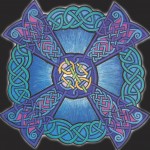 e two dogs alone at home for a short period than one. One pup is more likely to do mischief or start howling. Two dogs that grow up playing together stay playful and active. That’s much more healthy and more fun. Two puppies will eat better because they rival each other.
e two dogs alone at home for a short period than one. One pup is more likely to do mischief or start howling. Two dogs that grow up playing together stay playful and active. That’s much more healthy and more fun. Two puppies will eat better because they rival each other.
The disadvantages of two pups from the same litter:
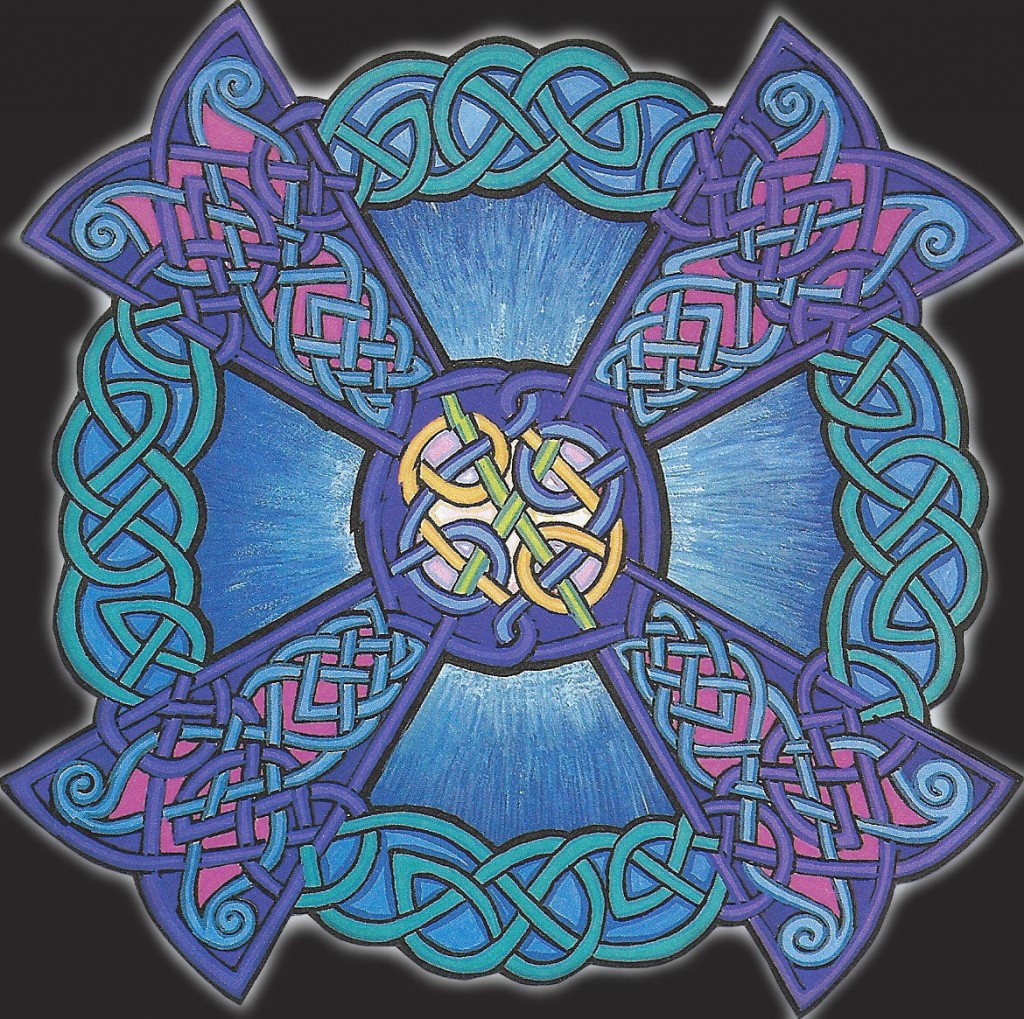 As owner you have to take care that you give them both adequate attention. For example take them on alternate days to puppy class, take them separately to the shopping mall (not when you’re shopping!) but make sure that someone is at home to look after the other pup and correct it if it does anything wrong (such as howling, biting the door jamb etc.)
As owner you have to take care that you give them both adequate attention. For example take them on alternate days to puppy class, take them separately to the shopping mall (not when you’re shopping!) but make sure that someone is at home to look after the other pup and correct it if it does anything wrong (such as howling, biting the door jamb etc.)
 Because their play is comparatively rough the chance of injuries and wounds is greater than with a passive singleton. One thing that must be remembered raising two coursing hounds together, especially littermates, is that they were bred to chase and should not be let off lead at the same time if you rely on “leash free” urban dog parks as a secure space to exercise your Deerhounds. If this is your only location for off-lead activity definitely don’t get two littermates!
Because their play is comparatively rough the chance of injuries and wounds is greater than with a passive singleton. One thing that must be remembered raising two coursing hounds together, especially littermates, is that they were bred to chase and should not be let off lead at the same time if you rely on “leash free” urban dog parks as a secure space to exercise your Deerhounds. If this is your only location for off-lead activity definitely don’t get two littermates!
 It will cost you twice as much money …. but it’s four times more fun than one dog!!!
It will cost you twice as much money …. but it’s four times more fun than one dog!!!
Think about these things before you start with a Deerhound. Most people begin with one but quickly take another and that can mean you have the problem of being able walk with one for hours (which is used to it) and not being able to do that with the new pup. Two of different ages has its own problems. You will have to be very careful with them playing together because an adult Deerhound is really too large and too heavy to be allowed to play with a puppy. That is an accident waiting to happen. Also the attachment between two littermates is different, more intense, than two from different litters.
I have until now always kept two or more pups from one litter and absolutely not experienced that you have less contact with them than with one. It was only from our last litter that I kept a single pup, Calhoun. When his littermate Cscarf left for England at the age of 8 months Calhoun was lonely and is that still. I still regret that he doesn’t have a brother or sister as playmate, despite that there are more Deerhounds around here but they are not proper playmates for him.
Finally, if there is only one pup, here are some guidelines on exercise. For a pup of 3 to 5 months the best thing is to go for “walkies” about 5-6 times a day for about 20-30 minutes. These “walkies” are really just a short stretch on leash to a nearby area or park, letting the pup wander around and then straight home as soon as it show signs of tiring. Some puppies will not stop if they are playing with another dog, but if you see them tiring you need to stop them. A puppy that is too tired will not eat, a puppy that doesn’t eat will not grow, and that causes a pause in their growth.
From the fifth month and on to about seven you can reduce the “walkies” to about three a day, but then they should last longer (about one to one and a half hours). In between if the puppy starts to get bored you can play with it in the garden or walk a small block. Not too slowly, let the puppy trot on a loose leash next to you. If you find it a nuisance that the pup wants to sniff at everything while it’s on leash, you should not allow that from the beginning. If you’re walking with one pup that’s not so bad, but can you imagine doing that with multiple dogs? Lots of fun for bystanders!
From the 7th month on you can build up the time and length of the walks (real leash walking). From the age of a year the healthy Deerhound should be able to easily take on a vigorous walk of at least an hour. Under vigorous I mean with a great deal of play and running. Take care to build this up gradually, not after five days with no walk suddenly in the weekend two hours in a row. How you split the walk time up doesn’t make much difference, but you can better for example walk two times half an hour and once one hour, than two times ten minutes and once two hours. In the first case the young dog will be less bored (at home) and the physical exercise and load is better spread out. When your dog is finally grown (around 2 years) it will matter less.
If you are not capable of giving your Deerhound free exercise, lots of running and play, and if you don’t have the time every day for at least 1½ to 2 hours to walk it, then consider another breed which fits in better with your lifestyle and don’t select a Deerhound (or other sighthound).
From about the age of one year you can also start cycling with your dog. Here too you need to build it up. The first time you take the bike in your left hand and the dog in your right. Walk in this way for a couple of hundred yards so that the dog can get used to the bike. If that goes well, then you can hold the bike between you and the dog. Make sure the leash is neither too long nor too short, the dog should be able to walk on the right of the bike with a loose leash. Neither before or behind the bike. The dog should move in a trot next to you and the bike and you keep talking to it to control it from jumping or pulling. Keep a close watch on the surroundings – a cat crossing the road can cause major problems! That’s why I use a choke chain while cycling, that way you can keep better control.
After two or three days you repeat the whole ritual so that the dog knows what’s going to happen but you can now go for a longer ride (if it all works out of course). Build it up gradually, two or three minutes as a maximum each time and watch your dog carefully. Don’t let it get tired, that is not good for the ligaments, tendons and joints, and it will discourage your dog from enjoying the outing. If the dog does enjoy it, and that is the most important thing, because if it doesn’t this can turn into a dangerous drama, then you can build it up until you can take the Endurance Test, which is 12½ mile in stages.
The average speed of a trotting Deerhound is around 12 kilometres or 7 miles an hour. Allow the dog to decide the right speed at which it feels most comfortable, never force anything! Check your dog’s pads at least once during and after the ride. If the dog comes up lame because there is some abrasion or wound to the pads stop immediately and return home. Only start again when the injury is completely healed. So always pay attention to the surface you are both on – are there any sharp objects or broken glass? Apart from your normal walks, twice a week 4 to 5 miles cycling should be enough to keep an adult Deerhound in top condition.
How do you know if your Deerhound has good muscle condition? You can feel this for example at the shoulder blade. If you can feel the scapular spine, the ridge that runs from the top of the blade down to the upper arm, then your dog has minimal muscle condition. With good condition you can barely feel this. The ribs should be covered with a firm web of muscle. The thigh and abdominal muscles should also be firm to hard. If you feel behind and under the last rib a firm muscle running in the direction of the hip, then your dog has good muscle condition. This can vary between individual dogs, one can have firmer tissue than another, but if you feel ‘blubber’ everywhere, then you really have your work cut out for you.
Coursing is a great sport for the Deerhound. This is not the same as running on an oval track, but chasing a lure (usually strips of plastic) on a line pulled over pulleys zigzagging a course on an open field. The length of the course can vary between 500 to 1000 metres (550 yards to 1100 yards) and the time that a fit Deerhound needs to run that is about 35 to 80 seconds. That is dependent on the type of ground, whether it is inclined or flat, how many turns and how sharp they are, the number of obstacles, whether the ground is hard or soft, water-logged, with long or short grass, all of this has a major effect on coursing. Coursing is judged and not solely on speed, but also importantly on steadfastness on the lure, enthusiasm, agility, courage, perseverance, endurance and intelligence.
One of the most important things about coursing is the warming up and cooling down of your dog, before and after the course. 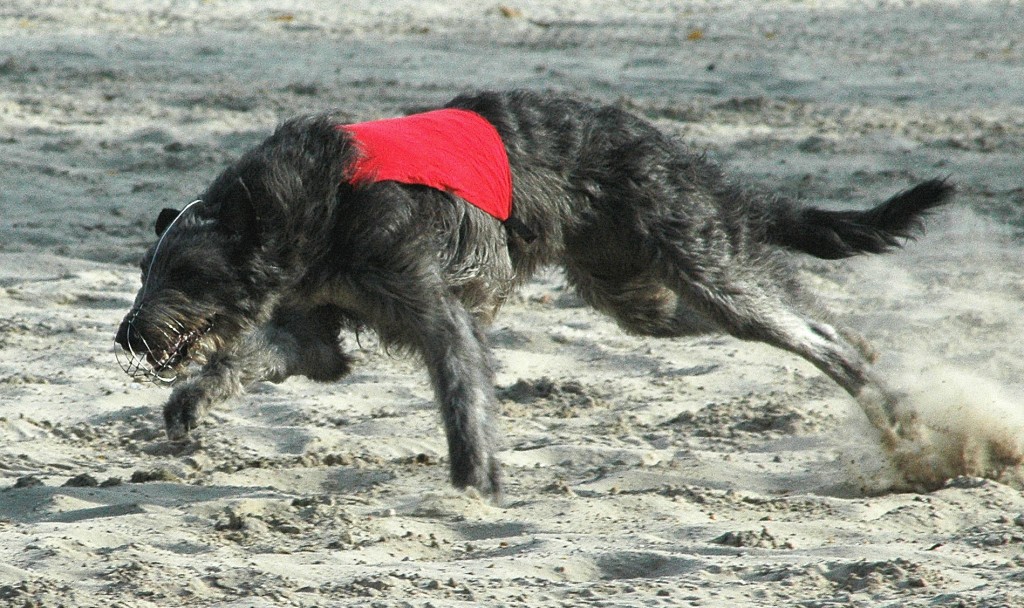 Warming up is necessary to warm the muscles up and get them supple, stretch ligaments and tendons and promote blood flow . This will help prevent injuries. Warming up costs about 15 minutes but will vary with each individual, don’t just walk but get some speed up. Cooling down is very important, something that a lot people of forget. Keeping the dog moving for at least 20 minutes will ensure that the waste products created in the muscles after major exertion can be removed and the metabolism can come to rest. Meanwhile the body temperature will gradually revert to normal. Directly after a course the body temperature can rise to as much as 41˚C or 105˚F and the heartbeat to 150 to 200! If you were to put your dog directly into the car after a course then this could have serious effects such as cramp and muscle pain because of acidification. So be warned, a good cooling down period is essential!
Warming up is necessary to warm the muscles up and get them supple, stretch ligaments and tendons and promote blood flow . This will help prevent injuries. Warming up costs about 15 minutes but will vary with each individual, don’t just walk but get some speed up. Cooling down is very important, something that a lot people of forget. Keeping the dog moving for at least 20 minutes will ensure that the waste products created in the muscles after major exertion can be removed and the metabolism can come to rest. Meanwhile the body temperature will gradually revert to normal. Directly after a course the body temperature can rise to as much as 41˚C or 105˚F and the heartbeat to 150 to 200! If you were to put your dog directly into the car after a course then this could have serious effects such as cramp and muscle pain because of acidification. So be warned, a good cooling down period is essential!
Sighthounds are in principal sight hunters, which means that they follow game that has been flushed using their eyes. If they lose the game then the hunt is over. There are however Deerhounds (and other sighthounds) that can scent well. I’ve often noticed that some of them can locate hares, cats, deer over more than a hundred metres/yards. The behaviour that they then show warns me so that I can stop them, but not always with success. Most of them do come straight back if they have lost the game … but others keep scenting and then you will just have to wait until they come back to you. But they (almost) always do.
A good Deerhound will at a given time show its hunting instinct, one may show it earlier and more fanatically than another, but unfortunately some Deerhounds never do and that is probably because they have never had the chance. That the Deerhound which has been trained to chase prey is more intense and fiercer than the one which has not been, is understandable. But it doesn’t mean that you can never let it loose because it will not listen and it will chase everything. This depends for the most part on how it has been brought up. If you have made it quite clear from the beginning what it can and cannot do, you have achieved a lot. It’s important to always pay close attention and be consequent. We advise everybody to take their pup to puppy class and start early with a recall that includes a distinctive, very shrill whistle as they can get beyond earshot very quickly when off lead.
This is very good for the puppy because of the socialisation and because they have to listen to you while a lot is going on around them. You will harvest major benefits from this later on! Train specifically in a Deerhound-friendly fashion – don’t order, but ask. And alwa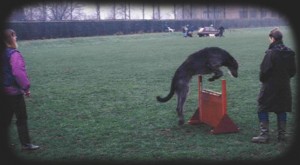 ys in a friendly fashion. Tone of voice is very important for a Deerhound, if it only suspects that its owner could be angry, it won’t do anything but try and creep away. You can achieve a great deal more with your Deerhound with friendly cheerful words. Argyll, the father of Lousy Lennon, took part in demonstration team for Elementary Behaviour and Obedience. Of course he didn’t do it just like a Shepherd dog, but he did it perfectly in his Deerhound way and earned a lot of admiration. Lennon followed in his father’s footsteps and earned his diploma. Prudence on the other hand found it terrible! She didn’t enjoy it for one moment and refused to continue. Whatever you do, cycling, coursing, agility, obedience, if your Deerhound doesn’t like it, it will let you know and then it’s not going to be any fun for you either! Having fun together, whatever the sport, is a must.
ys in a friendly fashion. Tone of voice is very important for a Deerhound, if it only suspects that its owner could be angry, it won’t do anything but try and creep away. You can achieve a great deal more with your Deerhound with friendly cheerful words. Argyll, the father of Lousy Lennon, took part in demonstration team for Elementary Behaviour and Obedience. Of course he didn’t do it just like a Shepherd dog, but he did it perfectly in his Deerhound way and earned a lot of admiration. Lennon followed in his father’s footsteps and earned his diploma. Prudence on the other hand found it terrible! She didn’t enjoy it for one moment and refused to continue. Whatever you do, cycling, coursing, agility, obedience, if your Deerhound doesn’t like it, it will let you know and then it’s not going to be any fun for you either! Having fun together, whatever the sport, is a must.
When your Deerhound is getting old it’s all the more important that it stays in good shape. There is nothing quite so sad than hav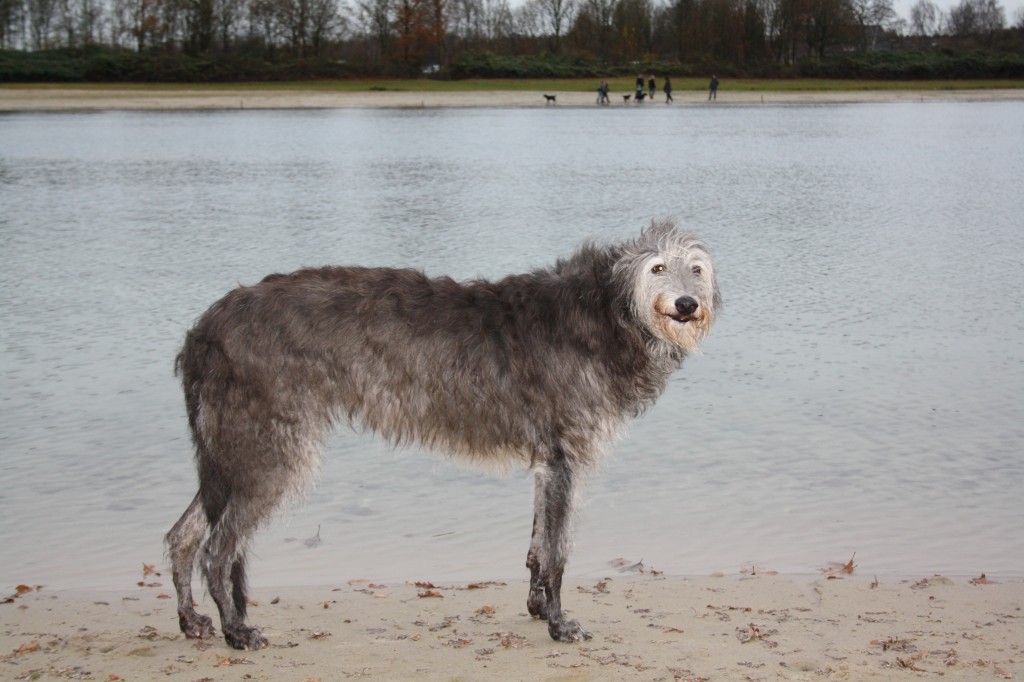 ing to put a healthy dog down because the muscles in the hindquarters through lack of exercise have got too weak to let it get up. So … keep walking. Only, a walk for two hours can better be spread over two times an hour or four times half an hour, in proportion to the age and condition of your elderly Deerhound
ing to put a healthy dog down because the muscles in the hindquarters through lack of exercise have got too weak to let it get up. So … keep walking. Only, a walk for two hours can better be spread over two times an hour or four times half an hour, in proportion to the age and condition of your elderly Deerhound
Our old Amy at 12 ½ used to walk for about 20 minutes three times a day, as well as wandering around our property for 15 minutes at a time, and in between she would often stand up to turn herself round. On a good day she stood up to eat and drink but she did prefer to be served! The most important thing is regular exercise so that they keep a good blood flow. When Amy was almost 13½ I had to help her get up but the four daily walks over a short distance but lengthy time – she stood still sniffing things more than she walked – gave her the necessary exercise and the distracting smells invigorated her!
 Mud shower
Mud shower
"Around Pentecost weekends we have been staying in Tüttleben (Germany) for a few years. In 2010 we had the Deerhound Jahresausstellung here. 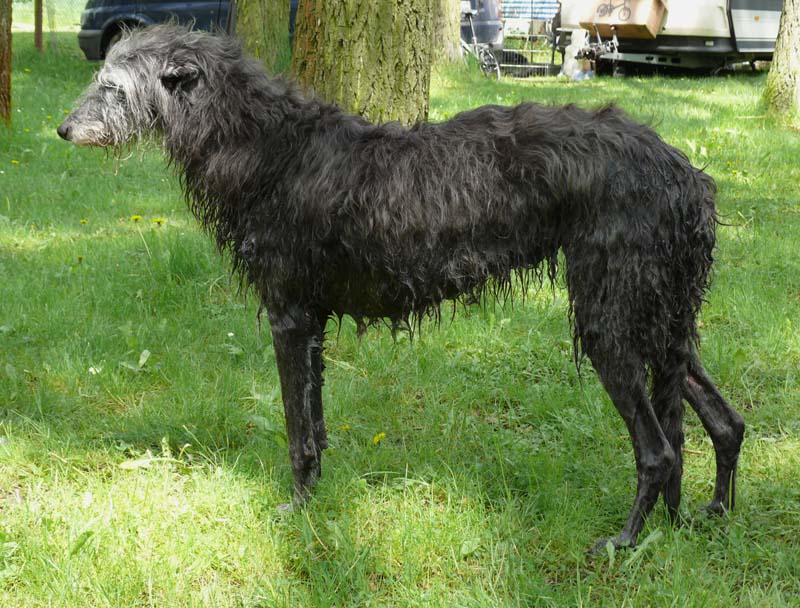 After a very wet period, which caused the whole environment to be a big mud, the sun broke through violently. Grandma Amy, as she has been called, is ten years old but it still does fine. The day before the show Simon goes with the stuff on the walk but soon the phone goes; Or I want to get Grandma Amy.
After a very wet period, which caused the whole environment to be a big mud, the sun broke through violently. Grandma Amy, as she has been called, is ten years old but it still does fine. The day before the show Simon goes with the stuff on the walk but soon the phone goes; Or I want to get Grandma Amy. 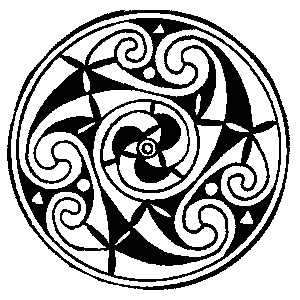 He had jumped in a blubbers loot to cool off, but was able to come out with a lot of trouble and was ready to walk. When I saw them I had to laugh terribly (and many with me) but that fared quickly when I tried to rinse them in a big puddle, the stinky, black, greasy drab was not out of her coat to get! Luckily I was allowed to wash them in the ladies shower with warm water and shampoo so that they could take part in the show very strangely the next day but presentable. " (This was for the first time in her life she was under the shower!)
He had jumped in a blubbers loot to cool off, but was able to come out with a lot of trouble and was ready to walk. When I saw them I had to laugh terribly (and many with me) but that fared quickly when I tried to rinse them in a big puddle, the stinky, black, greasy drab was not out of her coat to get! Luckily I was allowed to wash them in the ladies shower with warm water and shampoo so that they could take part in the show very strangely the next day but presentable. " (This was for the first time in her life she was under the shower!)
 Meatballs Special
Meatballs Special
"In early March 2010 I went with Sonja, Cheytah and Calhoun to Crufts, England. We would stay with a good girlfriend in a mobile home, spacious enough for us to celebrate. As usual I would take care of the dogs and Sonja eat it people. So the freezer, cooler and bags were filled. Since it was rather cold, the meat for the hounds was not completely thawed around their meal time yet. I threw the bag of pens in a saucepan with hot water and went on to throw all the ingredients together in a large bucket. Within fifteen minutes the trip was thawed and I kiepte it with the most moisture at the rest in the bin. There was still some pensvocht left in the pan, which could possibly be added later. Meanwhile, Sonja started our dinner. Broccoli with baked potatoes and meatballs in gravy. For the broccoli and potatoes she had found the right pans but for the meatballs with the gravy yet. Before I could react, Sonja turned the bowl with balls above the pan with Pensvocht. She had meant that it was empty and clean.
It took at least half an hour longer before the food was finished, we couldn't stop laughing anymore! It was the hardest meal so far, looking at each other could not and I had to constantly think that in other countries they also eat tripe otherwise I would not have gotten a bite through my throat. And our girlfriend, who had never eaten such delicious meatballs!
 My pants dropped from there
My pants dropped from there
"Years ago I walked with five Deerhounds on the line to walk on a small country road. Suddenly, about 5 meters before us a rabbit popped out of the bushes and instead of now rushing off, it bumped very inept for us. This was a myxomatosis rabbit. The hounds were totally crazy! I tried to keep them as long as possible so that the rabbit would dive away but the hounds just started walking faster and I had to follow. I still thought, "I'll hold them, don't let them down, they'll stop." Unfortunately they didn't do that and at some point I fell over while those… hounds just walked through. And I stick with my stupid head. Now I had a very comfortable trousers, so one with an elastic waist. You feel it already, at some point I felt the pants slipping slowly from my butt! Soon the hounds unleashed, looked around me if there was no chance to watch someone, got up and pants Opgehesen again. The rabbit didn't survive but I still have to chuckle when I think about it.
 A foreign grandmother.
A foreign grandmother.
One morning Simon, my husband, walks with the hounds through our bosgebiedje. Because there are quite a few cats in the woods and the chance of a meeting with a hare is not unimaginable, the six hounds are on the line, but because of her age, "Grandma" Amy may loose. At some point a sports trolley Simon will be forest trail on the day of the day. When the sports car was near, Simon went with the six on the side and finally did "Grandma" Amy, who walked a short time behind Simon, the same.
After a few minutes the sport car came back again, but now from behind. "Grandma" Amy, who can be terribly eastern Indian deaf, stayed like a queen walking in the middle of the path. First still in a jogged but when the sports car is near it goes into a worthy strides. The sports car could do nothing but keep tuffs at the back until "Grandma" Amy is with the rest of the group and Simon can direct her to the side. The sports car stops. A window is turned downwards and a large, barely car-fitting negro, becomes visible. "Certainly a Surinamese dog, Sir, there is no corridor in"!!!
 A charming granny Amy.
A charming granny Amy.
Since half a year, new residents have come to live with us in the forest. After some interior work, the gate was restored and a new entrance gate was placed. You guessed it, there also came a new dog. It turned out to be a somewhat older Mechelen Shepherd, Falko is his name. His function as a watchdog took him very seriously in most situations, but when we walked by he stood motionless and dead silent to watch. He still does, but since a few weeks his tail starts waving gently and again when "Grandma" Amy comes in sight. She always runs on her thawing convenience a bit behind me and previously she did like the other hounds, or she didn't see him. But recently she got interested in the elder Lord and walked very carefully to the fence. With a thick 10 centimeters between their noses, they greeted each other but that distance became smaller every day and the tails went a bit more violent every day. Now it's so far that Falko is eagerly awaiting the path when I'm over with the leashed pack and "Grandma" Amy occasionally with crazy Bokkesprong Rongen to Falko "Holt", greets him fondly and then stands to challenge for a game. Fortunately there is a fence between because "Grandma" Amy is no longer so stable on her old legs but between her ears she is still as fit as a grouse. It is and charming face, which is two gray snoetjes with subdued joy.
carefully to the fence. With a thick 10 centimeters between their noses, they greeted each other but that distance became smaller every day and the tails went a bit more violent every day. Now it's so far that Falko is eagerly awaiting the path when I'm over with the leashed pack and "Grandma" Amy occasionally with crazy Bokkesprong Rongen to Falko "Holt", greets him fondly and then stands to challenge for a game. Fortunately there is a fence between because "Grandma" Amy is no longer so stable on her old legs but between her ears she is still as fit as a grouse. It is and charming face, which is two gray snoetjes with subdued joy.
 A ferocious grandmother
A ferocious grandmother
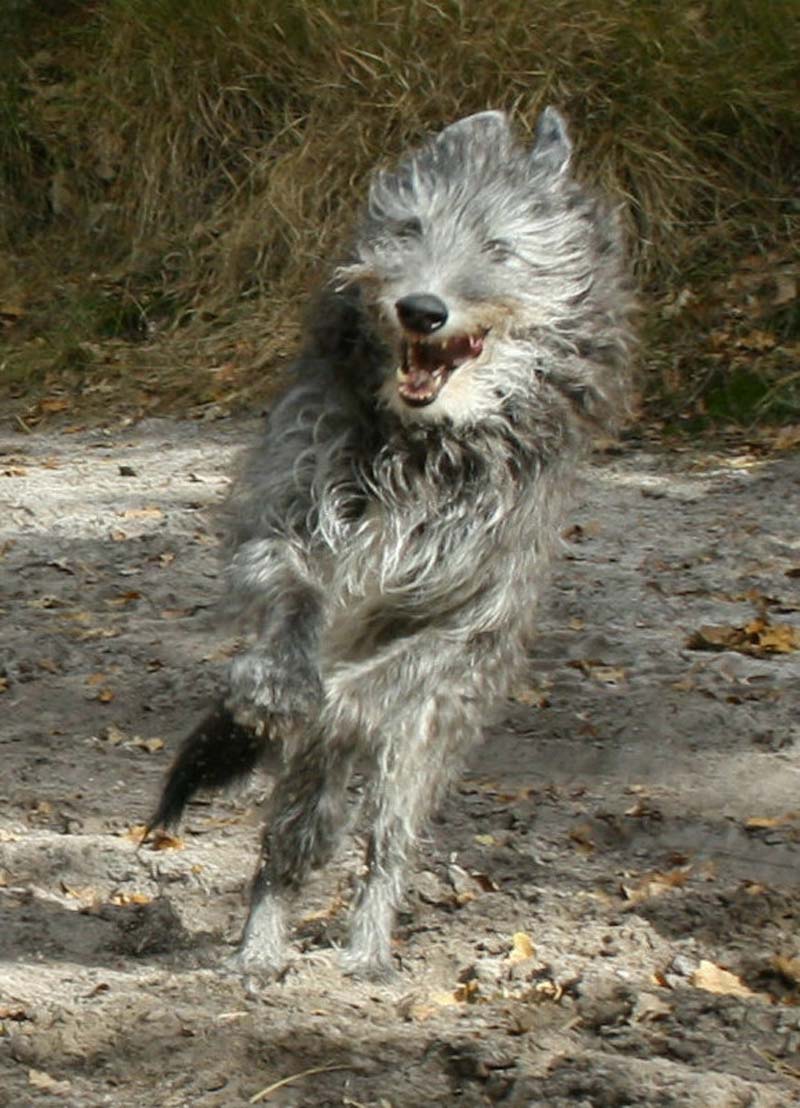 Normally when we go into the woods with our hounds, they run loose. For several reasons we had the six on the line and only walked "Granny" Amy, 10 years and 4 months, loose. At her own pace she ran a bit of sniffing and scurrying and occasionally she passed "fullspeed". At some point a jogger met us in the distance. We saw him already, so we went neatly on the side with the six so he could easily pass by. "Grandma" Amy stood 10 meters behind us on the side of the path to rummage. At a distance of 30 meters kept the jogger silent and already pointing to "grandma" Amy said he stammering: "and who then". You understand that we had to bite our tongue in order not to burst into laughter. But… as you can see on the picture below, "Grandma" Amy can still be very wildly out of the corner. Perhaps his fear was founded!
Normally when we go into the woods with our hounds, they run loose. For several reasons we had the six on the line and only walked "Granny" Amy, 10 years and 4 months, loose. At her own pace she ran a bit of sniffing and scurrying and occasionally she passed "fullspeed". At some point a jogger met us in the distance. We saw him already, so we went neatly on the side with the six so he could easily pass by. "Grandma" Amy stood 10 meters behind us on the side of the path to rummage. At a distance of 30 meters kept the jogger silent and already pointing to "grandma" Amy said he stammering: "and who then". You understand that we had to bite our tongue in order not to burst into laughter. But… as you can see on the picture below, "Grandma" Amy can still be very wildly out of the corner. Perhaps his fear was founded!
